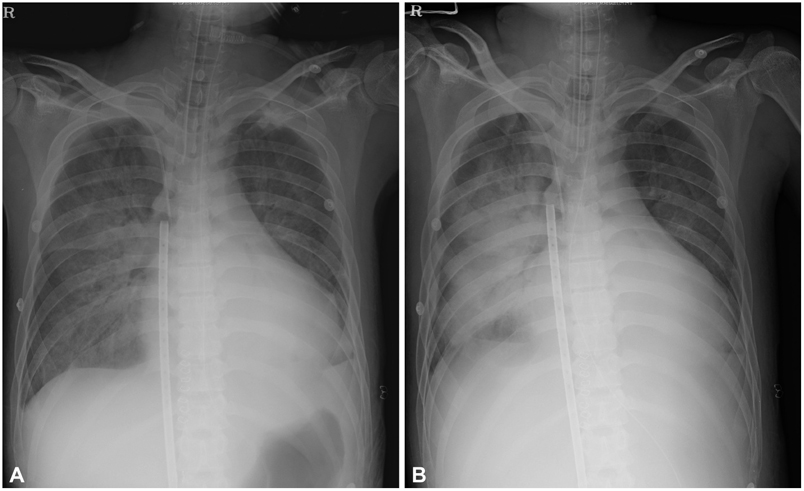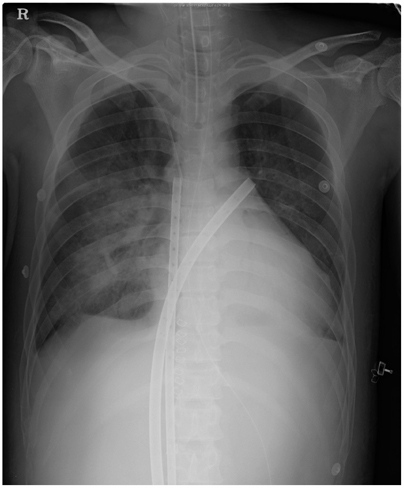Korean Circ J.
2011 Jul;41(7):402-404. 10.4070/kcj.2011.41.7.402.
Percutaneous Transseptal Left Atrial Drainage for Decompression of the Left Heart in an Adult Patient during Percutaneous Cardiopulmonary Support
- Affiliations
-
- 1Division of Cardiology, Department of Medicine, Samsung Medical Center, Sungkyunkwan University School of Medicine, Seoul, Korea. jyhahn@skku.edu
- KMID: 2225105
- DOI: http://doi.org/10.4070/kcj.2011.41.7.402
Abstract
- A 28-year-old male with hemophagocytic lymphohistiocytosis presented with left ventricular dysfunction and cardiac arrest. Percutaneous cardiopulmonary support (PCPS) was initiated, but left heart distension developed with associated aggravation of pulmonary edema. Percutaneous transseptal left atrial sheath (28-Fr) drainage was incorporated into the PCPS venous circuit under fluoroscopic guidance to enable left heart decompression 1 days after PCPS initiation. The patient's pulmonary edema improved markedly, and distention of his left heart diminished. He was successfully weaned from PCPS 5 days later. Percutaneous transseptal left atrial drainage with large venous cannulae is feasible and effective in decompressing the left heart in adult patients during PCPS.
MeSH Terms
Figure
Reference
-
1. Rhee I, Gwon HC, Choi JH, et al. Percutaneous cardiopulmonary support for emergency in-hospital cardiac arrest or cardiogenic shock. Korean Circ J. 2006. 36:11–16.2. Rajagopal SK, Almond CS, Laussen PC, Rycus PT, Wypij D, Thiagarajan RR. Extracorporeal membrane oxygenation for the support of infants, children, and young adults with acute myocarditis: a review of the Extracorporeal Life Support Organization registry. Crit Care Med. 2010. 38:382–387.3. Ward KE, Tuggle DW, Gessouroun MR, Overholt ED, Mantor PC. Transseptal decompression of the left heart during ECMO for severe myocarditis. Ann Thorac Surg. 1995. 59:749–751.4. Seib PM, Faulkner SC, Erickson CC, et al. Blade and balloon atrial septostomy for left heart decompression in patients with severe ventricular dysfunction on extracorporeal membrane oxygenation. Catheter Cardiovasc Interv. 1999. 46:179–186.5. Cheung MM, Goldman AP, Shekerdemian LS, Brown KL, Cohen GA, Redington AN. Percutaneous left ventricular "vent" insertion for left heart decompression during extracorporeal membrane oxygenation. Pediatr Crit Care Med. 2003. 4:447–449.6. Aiyagari RM, Rocchini AP, Remenapp RT, Graziano JN. Decompression of the left atrium during extracorporeal membrane oxygenation using a transseptal cannula incorporated into the circuit. Crit Care Med. 2006. 34:2603–2606.7. Guirgis M, Kumar K, Menkis AH, Freed DH. Minimally invasive left-heart decompression during venoarterial extracorporeal membrane oxygenation: an alternative to a percutaneous approach. Interact Cardiovasc Thorac Surg. 2010. 10:672–674.8. Creput C, Galicier L, Buyse S, Azoulay E. Understanding organ dysfunction in hemophagocytic lymphohistiocytosis. Intensive Care Med. 2008. 34:1177–1187.9. Karapinar B, Yilmaz D, Balkan C, Akin M, Ay Y, Kvakli K. An unusual cause of multiple organ dysfunction syndrome in the pediatric intensive care unit: hemophagocytic lymphohistiocytosis. Pediatr Crit Care Med. 2009. 10:285–290.10. Hammerstingl C, Lickfett L. Safety of single transseptal puncture for ablation of atrial fibrillation: retrospective study from a large cohort of patients. J Cardiovasc Electrophysiol. 2008. 19:E36. author reply E37.11. Babaliaros VC, Green JT, Lerakis S, Lloyd M, Block PC. Emerging applications for transseptal left heart catheterization old techniques for new procedures. J Am Coll Cardiol. 2008. 51:2116–2122.12. Liu TJ, Lai HC, Lee WL, et al. Immediate and late outcomes of patients undergoing transseptal left-sided heart catheterization for symptomatic valvular and arrhythmic diseases. Am Heart J. 2006. 151:235–241.
- Full Text Links
- Actions
-
Cited
- CITED
-
- Close
- Share
- Similar articles
-
- Left Atrial Decompression by Percutaneous Left Atrial Venting Cannula Insertion during Venoarterial Extracorporeal Membrane Oxygenation Support
- Left main artery stenting under percutaneous cardiopulmonary support after right coronary artery ST elevation infarction
- Cardiopulmonary Support for High Risk Percutaneous Transluminal Coronary Angioplasty
- The inverted left atrial appendage; the possibility of the interference with the bloodstream into the left ventricle during weaning from cardiopulmonary bypass: A case report
- Percutaneous Drainage of Epidural abscess in Lumbar Spin: Case Report



